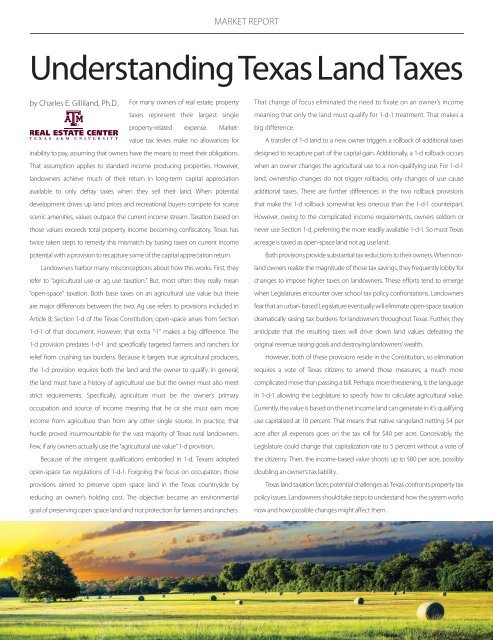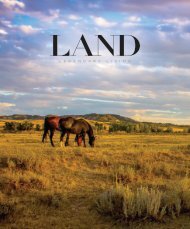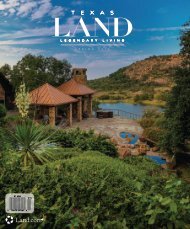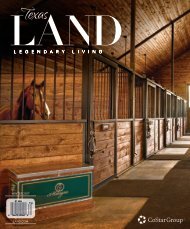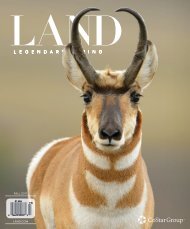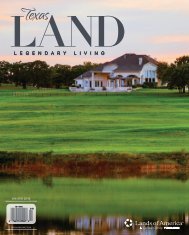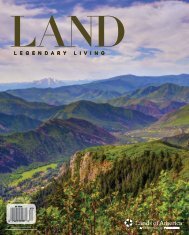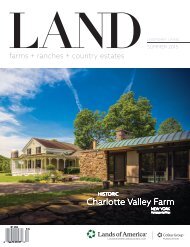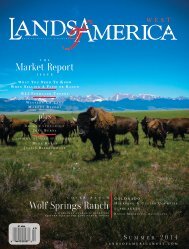You also want an ePaper? Increase the reach of your titles
YUMPU automatically turns print PDFs into web optimized ePapers that Google loves.
MARKET REPORT<br />
Understanding Texas Land Taxes<br />
For many owners of real estate, property<br />
taxes represent their largest single<br />
property-related expense. Marketvalue<br />
tax levies make no allowances for<br />
inability to pay, assuming that owners have the means to meet their obligations.<br />
That assumption applies to standard income producing properties. However,<br />
landowners achieve much of their return in long-term capital appreciation<br />
available to only defray taxes when they sell their land. When potential<br />
development drives up land prices and recreational buyers compete for scarce<br />
scenic amenities, values outpace the current income stream. Taxation based on<br />
those values exceeds total property income becoming confiscatory. Texas has<br />
twice taken steps to remedy this mismatch by basing taxes on current income<br />
potential with a provision to recapture some of the capital appreciation return.<br />
Landowners harbor many misconceptions about how this works. First, they<br />
refer to “agricultural use or ag use taxation.” But, most often they really mean<br />
“open-space” taxation. Both base taxes on an agricultural use value but there<br />
are major differences between the two. Ag use refers to provisions included in<br />
Article 8, Section 1-d of the Texas Constitution; open-space arises from Section<br />
1-d-1 of that document. However, that extra “-1” makes a big difference. The<br />
1-d provision predates 1-d-1 and specifically targeted farmers and ranchers for<br />
relief from crushing tax burdens. Because it targets true agricultural producers,<br />
the 1-d provision requires both the land and the owner to qualify. In general,<br />
the land must have a history of agricultural use but the owner must also meet<br />
strict requirements. Specifically, agriculture must be the owner’s primary<br />
occupation and source of income meaning that he or she must earn more<br />
income from agriculture than from any other single source. In practice, that<br />
hurdle proved insurmountable for the vast majority of Texas rural landowners.<br />
Few, if any owners actually use the “agricultural use value” 1-d provision.<br />
Because of the stringent qualifications embodied in 1-d, Texans adopted<br />
open-space tax regulations of 1-d-1. Forgoing the focus on occupation, those<br />
provisions aimed to preserve open space land in the Texas countryside by<br />
reducing an owner’s holding cost. The objective became an environmental<br />
goal of preserving open space land and not protection for farmers and ranchers.<br />
That change of focus eliminated the need to fixate on an owner’s income<br />
meaning that only the land must qualify for 1-d-1 treatment. That makes a<br />
big difference.<br />
A transfer of 1-d land to a new owner triggers a rollback of additional taxes<br />
designed to recapture part of the capital gain. Additionally, a 1-d rollback occurs<br />
when an owner changes the agricultural use to a non-qualifying use. For 1-d-1<br />
land, ownership changes do not trigger rollbacks; only changes of use cause<br />
additional taxes. There are further differences in the two rollback provisions<br />
that make the 1-d rollback somewhat less onerous than the 1-d-1 counterpart.<br />
However, owing to the complicated income requirements, owners seldom or<br />
never use Section 1-d, preferring the more readily available 1-d-1. So most Texas<br />
acreage is taxed as open-space land not ag use land.<br />
Both provisions provide substantial tax reductions to their owners. When nonland<br />
owners realize the magnitude of those tax savings, they frequently lobby for<br />
changes to impose higher taxes on landowners. These efforts tend to emerge<br />
when Legislatures encounter over school tax policy confrontations. Landowners<br />
fear that an urban-based Legislature eventually will eliminate open-space taxation<br />
dramatically raising tax burdens for landowners throughout Texas. Further, they<br />
anticipate that the resulting taxes will drive down land values defeating the<br />
original revenue raising goals and destroying landowners’ wealth.<br />
However, both of these provisions reside in the Constitution, so elimination<br />
requires a vote of Texas citizens to amend those measures, a much more<br />
complicated move than passing a bill. Perhaps more threatening, is the language<br />
in 1-d-1 allowing the Legislature to specify how to calculate agricultural value.<br />
Currently, the value is based on the net income land can generate in it’s qualifying<br />
use capitalized at 10 percent. That means that native rangeland netting $4 per<br />
acre after all expenses goes on the tax roll for $40 per acre. Conceivably, the<br />
Legislature could change that capitalization rate to 5 percent without a vote of<br />
the citizenry. Then, the income-based value shoots up to $80 per acre, possibly<br />
doubling an owner’s tax liability.<br />
Texas land taxation faces potential challenges as Texas confronts property tax<br />
policy issues. Landowners should take steps to understand how the system works<br />
now and how possible changes might affect them.<br />
48 LandsofTexasMagazine.com


